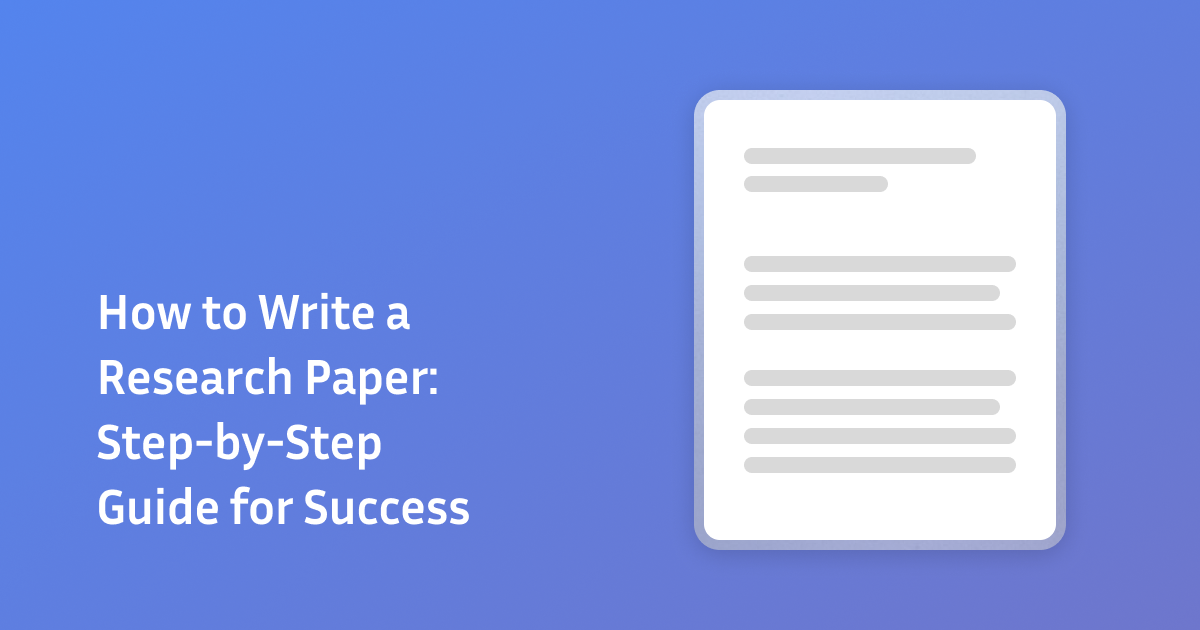How to Write a Research Paper: Step-by-Step Guide for Success

There are not many things in the world of academics that could make students fear more than the dreaded deadline of submitting their research paper.
Research papers are the term synonym for long hours combined with continuous hard work over a number of weeks. But if you know how to write a research paper then you'll find it is not that bad or at least not that painful task.
Today, with this article we are going to show you how to properly write your very first academic research paper, that too step-by-step.
Here, we are going to cover topics like choosing the right research topic, how to conduct a thorough research paper, outlining the research paper, writing the first draft, and finally, adding in the required citations and avoiding plagiarism.
What is Academic Writing?
Research papers are considered to be one of the most novel ways to help a focused audience understand the experiment that you have done earlier.
These individuals might be interested in replicating the experiment, as well as popularizing your research to the world. In addition to this, with a research paper in place, you will prevent the duplication of your studies and the findings.
Writing a research paper is one of the prime methods of sharing knowledge with scientists and individuals who are working in the same or related fields. It is crucial to have skills in writing a paper to demonstrate how much you have truly understood the concepts that were part of your experimentation.
Writing Process
Now that you understand the concept of a research paper and how it is completely different from any other form of writing, let's move on to the next part, which will show you how the writing part of the research paper is done. Follow these steps to write down your first research paper.
Choosing a Research Topic
Finding out the topic for your research can be a tough nut to crack; when deciding on a topic, you must make sure that the topic you will be choosing is focused on your learning and is unique. Apart from that, here are a few things to consider:
- The topic must meet the assignment requirements; you can ask the professor to give you feedback on the topic you have selected.
- Choose the topic that interests you; it will make the research more fun and less tiresome.
- Consider the scope of your topic; if it is too broad, it may be hard to pinpoint the required information; on the other hand, if it is too narrow, it will be much harder to find any information at all.
- Also, before finalizing your research topic, it is best to do a preliminary search to determine whether there is enough information available that is valid to set the context of your research.
Conducting Thorough Research
When the topic is finalized, the next thing to do is direct your focus toward the research; you can begin by locating the research material on the internet. Apart from the internet, there are a number of other places you can look for the information.
Here are 5 tips that will improve your research methodology and hone your writing skills.
- We know research is a big task, so it can be overwhelming to know where to start. Slowly dive into the specifics and start with the basic Google research to orient yourself in a topic; it will give you a basic overview along with a brief history along with key points.
- See, not every resource is reliable, so it is recommended to recognize the good sources from the not-so-good ones. Check if the source agrees with the other sources which you find? Is the author of the source an expert in the field? Does the author's point of interest conflict with the topic?
- Make sure to verify information from various resources. The internet is a big place; everyone can say whatever they want, no matter if they are experts on the topic or not. So, the best way to find factual accuracy is to compare your findings with several different resources.
- During the process of data collection, you will go through a huge amount of information; it can be present in the form of PDFs, web pages, power points, blogs, research papers, articles, and even YouTube videos. As a result, it is a necessity to keep all the information organized and prevent losing anything. Use Bookmarks in your internet browser, index cards, and an annotated bibliography that will keep you updated as you go through.
Research with Paperguide AI’s Research Assistant
Paperguide AI’s Research Assistant can fetch thousands of papers online to show you the insights and analysis that truly matter for your niche. You can select the AI Search or Literature Review option from the AI Research Assistant, as shown below.
For this example, we checked for papers on “The Impact of Social Media on Mental Health”. Here’s the analysis that Paperguide’s AI showed:
This analysis is from the top papers for that particular search, and also shows the exact sources the insights are taken from.
If you scroll below, you’ll find a comprehensive table that allows you to create columns based on your needs. There are columns available for organizing papers based on Summary, Research Question, Key Findings, and many more. By default, the table provides information on papers and their key findings (which are gathered through AI algorithms).
The Free plan allows you to create up to 5 custom columns for Literature Review, based on your requirements. Upgrading to Starter and Advanced plans allows you to create up to 8 and 50 columns respectively.These easy-to-use features of Paperguide AI will help you collate all the research into a single platform, streamlining your research process.
Crafting a Thesis Statement
A great thesis statement needs to have some sort of stand, what we mean is your thesis needs to show your conclusions about the subject, so you have to be decisive and specific.
Besides this, your thesis statement needs to have a point of discussion; you can elevate the statement by showcasing that the topic is controversial.
Readers are more likely to read through the rest of the research paper to see how you support your point. Finally, to create a strong thesis statement you must be able to put all how and why related to your topic through a specific language.
Understanding the Research Paper Structure
The very first thing you need to do before you start writing the research paper is get organized. By this point, you have the topic in your mind and tons of notes that you made during the research, along with the data that you have compiled. Now all of this has to be organized in a cohesive way to form a structure of your research paper.
Here's a basic shape of a research paper
- Introduction
- Thesis Statement
- Body
- Topic Sentence
- Evidence
- Analysis
- Transition
- Conclusion
When you are writing down the introduction of a research paper, make sure to include a hook that captures the attention of readers. Once that is done, write down the reason for your research and what problem it solves at the end.
The thesis is one of the shortest parts of your research paper, and it falls at the very end of your introduction. The statement conveys your position and the essence of your argument, the idea behind doing the research.
The body is where you include the evidence, analysis you have done, and results that came from the experiment. Finally, use transitions to keep the flow intact of your entire research paper. You can put up a short transition phase, like "In contrast", to make the readers go from one phase of your research paper to the next.
Outlining Your Paper
An outline of a research paper is more of a basic format for writing down an academic research paper, which follows IMRAD format, which is Introduction, Methods, Results, And Discussion. This outline varies depending on the type of manuscript you get from the university.
Here are a few of the steps that you should be following to create an impeccable research paper outline:
- First, you need to write down all the important ideas that come to your mind that are related to your research topic.
- Try to come up with answers such as what is the main topic of my paper? How is the topic important in my industry? How should I be formulating the hypothesis? What will be the major findings in my research paper?
- Group all your ideas into different sections—introduction, methods, results, and conclusion.
- Do not forget to add relevant questions in each section of your research paper. Also, it would be great if you note down the question prior to reaching that section. This will help you in aligning your thoughts.
- Now, start expanding on the ideas based on the questions created in the paper outline.
- Once the outline is made, discuss the same with your mentor and peers.
- After taking notes from the feedback, it is time to decide on the journal you will submit to.
- At last, the outline of your research paper is made, and all you have to do is start writing down your findings in a proper format.
How Paperguide AI Helps You Create an Outline
Paperguide’s AI Writer feature provides an option to create an outline through its AI algorithms.
Choose the AI Writer option and create a new document or select one that you already have.
Once you’ve started working on the document, you can select Paperguide’s Ask AI button, and it’ll provide you with multiple options to utilize the AI.
Select the Create Outline option and then click on the Ask AI button once again.
The AI will then create an outline based on an analysis of the top papers. You can accept the suggestion or ask for alternatives.
Overall, this is an excellent way to reduce the time taken to set a structure for your research paper!
Writing the Draft
When you are drafting a research paper, the main objective is to have an initial go at presenting the analysis, while at the same time continuing your analysis.
In the draft creation process, you are bringing together and synthesizing the ideas that came across during the research, the ideas presented in the draft will be further refined and organized as you write the final research paper.
Here are things you need to include in your research paper's draft:
- First, you need to have a statement of your research question.
- Then, include the organized presentation of your analysis according to the various themes or concepts that are part of your research paper.
- Representation of data that supports your analysis.
- Showcasing how you reached the analysis and, at the same time, include the preconceptions that you have in mind and how those preconceptions have changed.
- Reflecting how well you have been able to answer the question on which your research paper has been put along with the data that supports it.
- Finally adding how your research paper has helped in extending the knowledge of the topic.
Using Paperguide AI Writer to Write Your Draft
As mentioned earlier, Paperguide provides an AI Writer feature to handle all your draft writing woes. Just like how it helps you create an outline, you can use the tool’s AI-powered features to write introductions, conclusions, key points, generate opposing arguments, and even transitions.
Plus, you can give it instructions to make your text undetectable via AI checkers or humanize it, although the latter is available on a paid plan.
And yes, there’s also a plagiarism checker to help you avoid any and all plagiarized content for your paper. This ensures that all your writing and content are completely original.
Incorporating Citations and Avoiding Plagiarism
After writing down the draft of your research paper, the next thing to do is add in all the citations and make sure that your content is plagiarism-free. The main reason why you should be citing references in your research paper is because it will help you avoid any form of intellectual dishonesty.
In addition to this, presenting ideas of other scholars without adding their references in citations goes against scientific ethics. Even though it is not considered to be the most ethical thing you can do when writing a research paper, it still falls under the category of basic decency.
Likewise, with proper citations, you will have the freedom to quote the work of others without getting caught under plagiarism. It allows readers of your research paper to acknowledge where the information truly came from.
Here are the basic elements of citations that you need to add to your research paper:
- Author(s)
- Title(s)
- Source or venue name (e.g., name of the journal it was published or conference where it was presented)
- Editor(s)
- Volume and edition
- Date or year of publication
- Page numbers
- City and country
- Publisher or university for theses
- URL for online sources
- DOI
- Retrieval date for online sources with dynamic content subjected to change
Cite Your References Using Paperguide AI’s Reference Manager
Just like the AI Writer tool, Paperguide also provides an AI-powered Reference Manager to help you manage and organize your research citations.
You can check for papers via various filters, such as whether or not they have PDFs, their type, author, and year of publication. Plus, Paperguide allows you to upload PDFs to extract data or use the Chat with PDF feature.
The latter option allows you to get summaries, methodology, limitations, key insights, and more, all through AI. Plus, you get to organize all of your references via information like full citations, annotations, bib information, and DOI.
Reviewing and Editing Your Paper
Editing and reviewing your research paper before submission is one of the most crucial things a scholar does. These two processes improve the quality of your research draft as they make your content clearer, precise, to the point, and impactful.
The readers of your research paper also assess it on the basis of language, quality, and how presentable the information is in the research paper.
The editing process of a research paper has various sub-parts, like correcting the grammar and finding out errors in punctuation and spelling mistakes. Furthermore, it includes improving the overall writing style and structure of the research paper so the target audience can comprehend the content with ease.
Here are a few tips that will help you edit your research paper in a proper format:
- First, you need to identify areas of concern in the draft and work on them.
- Then create an editing checklist to make sure you have followed all the required guidelines that are necessary to submit the journal.
- When you are adding or deleting a word from a sentence make sure to re-read it twice to see if the context is still intact and to see if the sentence is grammatically correct or not.
- Read the paragraphs aloud; this way, you will be able to find areas where grammatical errors are present, or sentences don't add up.
- It is best to use transition words and phrases to create a link between different paragraphs.
- Remove redundant words and any unnecessary information that your research paper doesn't need.
- Keep the sentences short or up to 30 words maximum so they can be to the point.
- Finally, focus on explaining one idea per section; if you are explaining two things in one section, you have to divide it so that readers can understand each module with better clarity.
Finalizing the Research Paper
Kudos to you—you are finally done with the challenging part; now it's time to wrap up your research paper for the final submission.
Before you do the final check, you must have completed the above-mentioned steps, which include making changes in the content of your work. Read the research paper yourself multiple times and ask others to do the same.
After you receive the feedback from the people, make changes in your text, and polish up your wording, the intellectual work ends here.
- Check if your cover page met all the necessary guidelines that were given by the university or the publication in which you will be submitting the paper.
- Add in the abstract if you are submitting the research paper as a supporting document of your master's thesis.
- Add the table of contents along with the page number at the beginning of your research paper to make it easier for readers to go back and forth from one section to the other.
- Save your research paper in the right format; on the other hand, if you are submitting a printed copy, ensure that the Word document is converted into PDF so that the formatting remains exactly how you want it to be.
Conclusion
Research papers are the bedrock of modern science, and even though we are living in the most advanced era right now, information can be shared in seconds all over the world. The relevance of research papers still prevails, and with them, researchers are able to state their findings in playing sight for everyone to access and learn from.
Before making the final submission, give yourself some time to wrap up the research paper formatting and printing a few days before to be sure that you haven't rushed anything.
Lastly, go through the checklist you have made for the final submission to see if you ticked off all the pointers.
Once everything is done and you have successfully submitted the research paper, there's one last thing that needs to be done: celebrate!
Frequently Asked Questions
1. How do I choose a suitable topic for my research paper?
You need to find a topic that is related to your field of education, along with a field that interests you.
2. What is the correct structure for a research paper?
A typical research paper includes the following sections: introduction, methods, results, and discussion.
3. How do I properly cite sources in a research paper?
When writing down a research paper this is the entire citation format that you need to follow: author, title of article, title of journal, volume, issue, date, page numbers, and doi or permalink.
4. How can I avoid plagiarism in my academic writing?
By providing proper citations to the references that you have used. In addition to this, there are certain applications available on the internet that can rephrase the content for you, so you can try them out as well.
5. How can I improve the clarity and coherence of my writing?
To improve coherence and clarity, you have to take out unnecessary sentences, words, and phrases that do not add any knowledge to your research paper. Re-read your paper multiple times, and that too aloud to find grammatical errors and mistakes.





